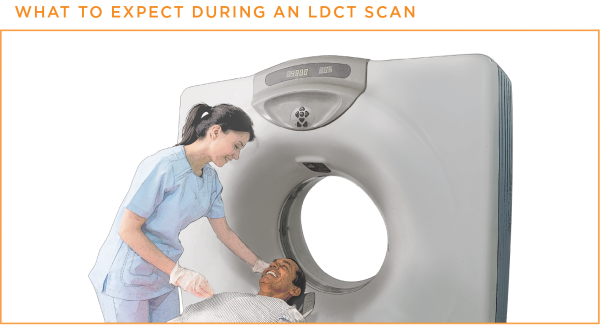The low-dose CT (LDCT) scan is a computerized X-ray imaging procedure that yields detailed pictures, or scans, of areas inside the body. Because the scanning produces multiple images from different angles, it can show both two-dimensional (2D) and three-dimensional (3D) images of anything abnormal in the chest. LDCT images show more detail than a traditional X-ray.
LDCT is a painless and noninvasive procedure; the patient needs no dyes or injections and has nothing to swallow.
The LDCT scan itself takes less than a minute. During the procedure, the patient lies very still on the CT table. Depending on the scanner, either the table passes slowly through the center of the scanner or the table stays still while the scanner moves around the patient. There might be whirring sounds during the procedure. At times during the procedure, the technician operating the equipment will ask the patient to hold his or her breath; this prevents blurring of the images.
A CT scan can provide very detailed information, including the size, shape, or location of an abnormality. However, a scan cannot diagnose whether or not an abnormality is cancer. What happens when a pulmonary nodule is found is discussed in a later section.

LDCT Drawbacks and Risks
Despite the benefits of LDCT lung cancer screening, including decreased mortality from lung cancer, decreased mortality from lung cancer treatment, and improved quality of life, there are some drawbacks and risks, including that LDCT may:
- Find abnormalities that have to be checked with either another scan or a biopsyThe removal of cells or tissues for examination by a pathologist if considered suspicious; the vast majority of the time these end up not being cancerous
- Miss very small cancers or cancers that are hidden behind other structures in the chest
- Expose a patient to a small amount of radiation. While it is a smaller dose than that from a standard CT scan, multiple LDCTs can lead to greater radiation exposure. High doses of radiation exposure can lead to other types of cancer in the future
- Detect tumors that would not become problematic. Such tumors may be indolent (tumors that grow slowly and may not always require treatment)
- Have costs for the patient that are not covered by the patient's insurance
- Cause stress while waiting for test results
In addition:
- Not all tumors that are found will be at an early stage
- Screening can only be done at facilities that can perform an LDCT, so a patient may have to travel to obtain a screening
It is important to keep in mind that an LDCT can find other abnormal growths in tissues outside the lungs (incidental nonpulmonary findings). These findings need to be followed up on by your doctor or specialist.
